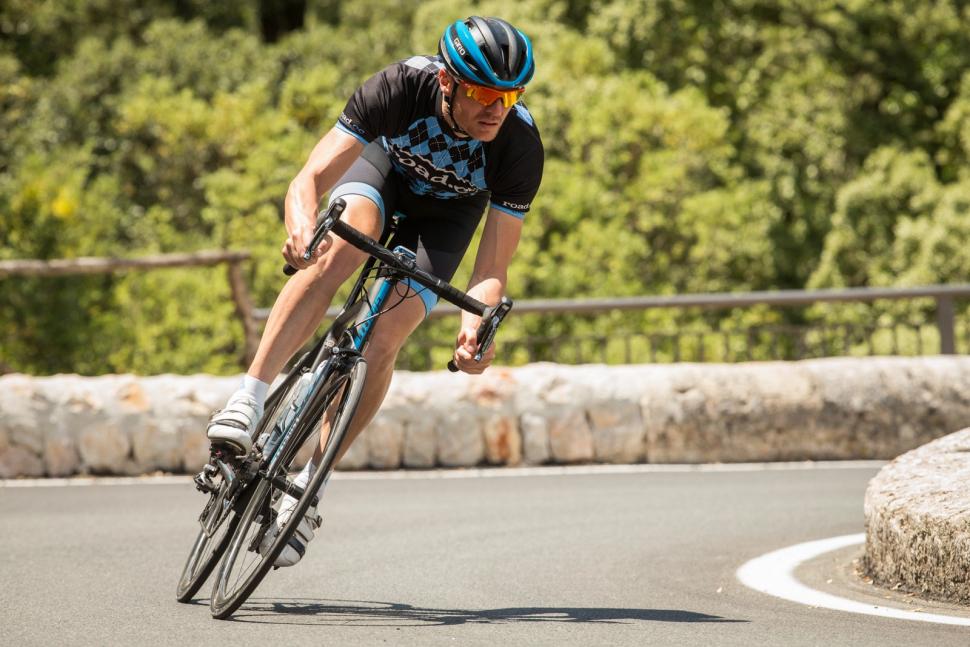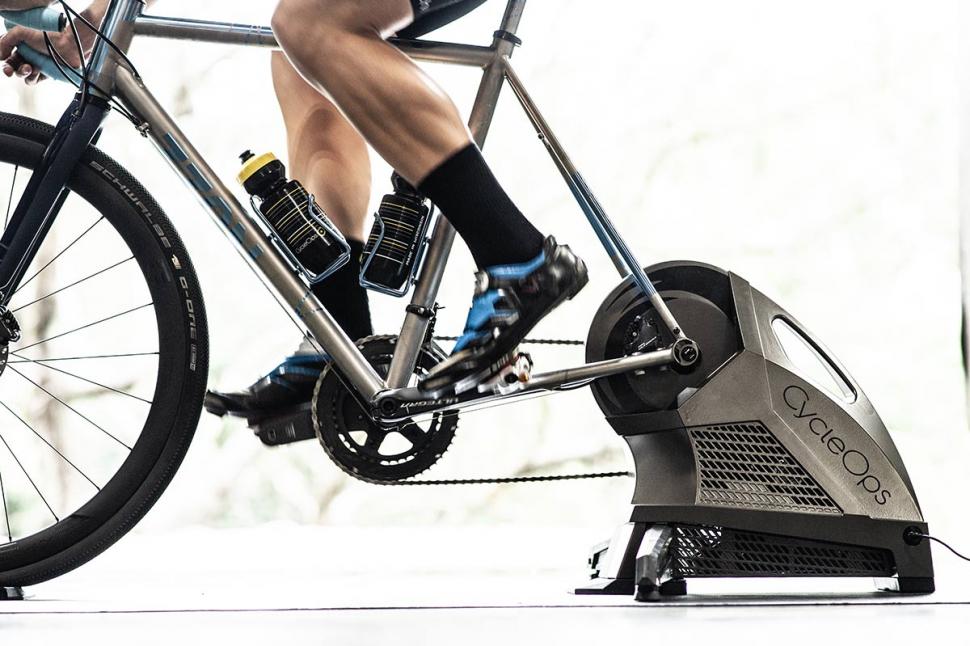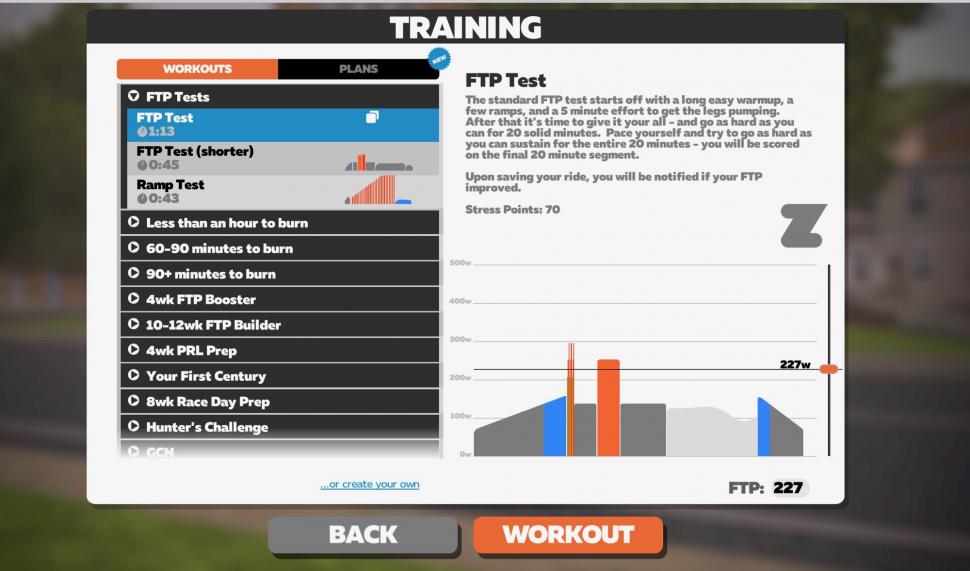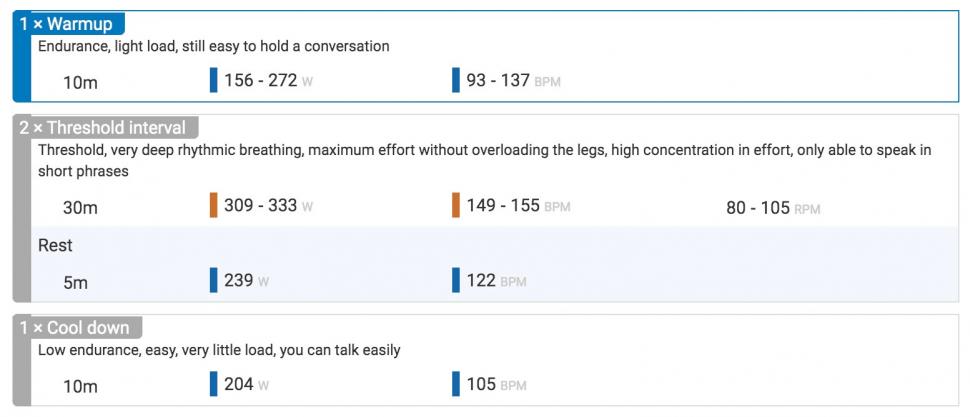- News
- Reviews
- Bikes
- Components
- Bar tape & grips
- Bottom brackets
- Brake & gear cables
- Brake & STI levers
- Brake pads & spares
- Brakes
- Cassettes & freewheels
- Chains
- Chainsets & chainrings
- Derailleurs - front
- Derailleurs - rear
- Forks
- Gear levers & shifters
- Groupsets
- Handlebars & extensions
- Headsets
- Hubs
- Inner tubes
- Pedals
- Quick releases & skewers
- Saddles
- Seatposts
- Stems
- Wheels
- Tyres
- Tubeless valves
- Accessories
- Accessories - misc
- Computer mounts
- Bags
- Bar ends
- Bike bags & cases
- Bottle cages
- Bottles
- Cameras
- Car racks
- Child seats
- Computers
- Glasses
- GPS units
- Helmets
- Lights - front
- Lights - rear
- Lights - sets
- Locks
- Mirrors
- Mudguards
- Racks
- Pumps & CO2 inflators
- Puncture kits
- Reflectives
- Smart watches
- Stands and racks
- Trailers
- Clothing
- Health, fitness and nutrition
- Tools and workshop
- Miscellaneous
- Buyers Guides
- Features
- Forum
- Recommends
- Podcast
feature
 FTP test - 1
FTP test - 1What is FTP? 7 key facts to learn about functional threshold power, a major training metric
FTP stands for functional threshold power and it's usually described as the highest average power output you can sustain for an hour, measured in watts. One of the first things most riders do when starting to train by power is to find out their FTP as a means of defining training zones, using online training tools, and having as a benchmark for measuring changes in fitness over time.
What is FTP?
Your FTP is defined as the highest average power that you can produce for 60 minutes. Performing a 60-minute maximal test is very difficult, of course, which is why many people prefer to calculate FTP as 95% of the highest power they can average for 20 minutes. We'll come back to measuring your FTP in a bit.
Why is FTP seen as important?
The concept of FTP was developed by Dr Andrew Coggan, co-author of Training and Racing with a Power Meter.
"Power at lactate threshold is the most important physiological determinant of endurance cycling performance, since it integrates VO2 max, the percentage of VO2 max that can be sustained for a given duration, and cycling efficiency," says Andrew Coggan.
"As such, it is more logical to define training zones relative to an athlete’s threshold power vs., for example, power at VO2 max."
Lactate threshold and FTP aren't the same thing (while VO2 max is the measurement of the maximum amount of oxygen your body can use during intense exercise). Lactate threshold refers to a specific physical change in the body. It is the point at which lactate begins to increase exponentially in your blood. Your lactate threshold can only be truly determined through blood tests.
Coggan says that lactate threshold and FTP are closely related. One is reflective of the other. FTP is the maximum power you can maintain while your body can still clear excess lactate being produced by your working muscles, allowing you to sustain your effort.
According to cycle coach Hunter Allen, also co-author of Training and Racing with a Power Meter, "Your lactate threshold (or FTP) provides a solid basis for any power meter-based training program, because your level of effort when exercising at a given intensity depends upon your power output relative to your power at FTP. When your power output exceeds your FTP, you’ll fatigue quickly. When your power output is just below FTP, you’ll be able to maintain it much longer.
That's the theory upon which the use of FTP is based, and it has been hugely influential in the cycling world for years. For example, all of the personalised workout targets and data analysis in the TrainingPeaks online and mobile software platform is based on FTP. TrainingPeaks uses other measurements too – Normalized Power (NP), Intensity Factor (IF) and Training Stress Score (TSS), for example – but ultimately everything comes back to FTP.
Not everyone holds FTP in such high regard. We'll come back to their arguments down below, but let's go with it for the time being.
Equipment
You need a power meter on your bike or a smart trainer with an integrated power meter to measure FTP. Power meters were once an option only for professionals and those amateurs who were both ultra-keen and loaded. Thankfully, they have become far more accessible in recent years.
Granted, SRM cranks still cost from about £1,600 but prices of single-sided crank-based 4iiii Precision Power Meters start at under £300, so you don't have to spend a fortune to get into training with power these days.
Find out how to choose a cycling power meter
How to perform an FTP test
You can perform an FTP test on a turbo trainer or out on the road. A turbo trainer has the advantage of allowing you to ride against a consistent resistance without interruptions to your effort caused by traffic, junctions or sharp turns. However, many coaches advise that you do your test on the road for the most accurate results.
Hunter Allen, Andrew Coggan and Stephen McGregor suggest this protocol in Training and Racing with a Power Meter:
1. 20-minute warm up at moderate pace.
2. 3 x 1-minute at 100rpm cadence with 1 minute easy pedalling in between.
3. 5 minutes riding all out. Start at a high pace and kick it up in the last minute.
4. 10 minutes pedalling at endurance pace.
5. Main segment: 20-minute time trial, putting out a strong, steady effort for the duration. Get up to speed and then try to hold that speed as steadily as you can.
6. 10-15 minutes pedalling at endurance pace.
7. 10-15 minutes easy pedalling.
They suggest doing the test on a fairly flat road or, if you're a first timer, on a steady climb or into a slight headwind, the idea being that this will force you into putting out a maximum effort for the entire 20 minutes.
Your aim is to produce the highest average watts possible over the 20-minute main segment, which means working to your maximal steady-state power. You might not get it right first time. You might go off too hard and fade towards the end, or you might start too easy and have to ramp it up a lot towards the finish. Riding at the right intensity will come with experience. Once you have your first FTP figure you'll know whereabouts you should be aiming in future.
If you've followed the protocol above, take your average power for the 20-minute main segment and work out 95% of that figure to get your FTP.
If you averaged 280 watts, for instance, 95% of 280 (0.95 x 280) is 266 – so your FTP is 266 watts. Why the calculation? It's because FTP refers to the highest average power you can hold for 60 minutes, and, according to Coggan et al, you can probably hold about 95% of your 20-minute figure for 60 minutes.
Of course, if you ride a 60-minute main segment, your average lap power is your FTP and there's no need for adjustment.
Many coaches suggest testing your FTP every six weeks during training.
Some online systems, such as Zwift, offer their own FTP tests. You just select the workout and follow the instructions.
What to do with your FTP figure
Okay, so you have your FTP figure. Now what?
Your FTP can form the basis of training zones that you (or a coach) can then use when producing a structured training programme.
There are various different training zone systems out there but Andrew Coggan's Power Zones are widely used.
| Level | Name | Percent of FTP | Time |
|---|---|---|---|
| Zone1 | Active Recovery | Up to 55 | 70-80 years |
| Zone 2 | Endurance | 56-75 | 2.5 hours to 14 days |
| Zone 3 | Tempo | 76-90 | 2.5-8 hours |
| Zone 4 | Threshold | 91-105 | 10-60 minutes |
| Zone 5 | VO2 max | 106-120 | 3-8 minutes |
| Zone 6 | Anaerobic capacity | Greater than 121 | 30 seconds-2 minutes |
| Zone 7 | Neuromuscular power | (maximal effort) | 5-15 seconds |
A cyclist with an FTP of 300 watts can calculate, for example, that Zone 1 active recovery rides should be ridden at up to 165 watts, for example, Zone 2 endurance rides should be above that level and up to 225 watts, and so on. (We're not going to go into the mechanics of designing a whole training programme here; that's a whole other feature.)
Many online training tools use your FTP as the basis for designing training programmes and specifying individual sessions. A short training session might be given to you like this:
•10 minutes warmup @ 147-256 watts
•2 x 24 minutes @ 291-313 watts with 5 minutes @ 225 watts between
•10 minutes cool down @ 192 watts
...or whatever. The specifics aren't important; you get the idea. You get clear instructions for every ride and all you need to worry about is hitting the right numbers.
The limitations of FTP
Okay, so far we've given what you might call the conformist line on FTP. Everyone agrees, then? Nah, of course not.
Golden Cheetah analytical software uses Critical Power (CP) rather than FTP.
"CP represents the power an athlete can sustain for a very long time, without fatigue, in theory," says Golden Cheetah. "It is calculated using a model and time to exhaustion tests of 2 and 12 or 20 minutes. Functional Threshold Power (FTP) is an estimate of the power an athlete can sustain for about 60 minutes or a 40km TT. There is no formal model or protocol for establishing it, most people use rules of thumb like FTP is 95% of 20 minute power, or they use the best power from a 40km TT.
"In practice, CP and FTP are usually close to each other. But since it is very difficult for an athlete to maintain the desired intensity FTP 'reality' tends to result in a number that is much lower than CP 'theory'."
Golden Cheetah also uses other metrics that we won't go into here. The bottom line is that Golden Cheetah believes that it is "able to provide the best analysis available, but at the cost of a steep learning curve for new users".
The Sufferfest app uses its own Four-Dimensional Power (4DP) test.
"Using FTP for your workouts is like only giving a tailor your waist size and asking them to design a suit for you... It’s not really going to fit," says Dylan Robbins, The Sufferfest's Senior Minister for External Affairs (no, really, that's Dylan's job title).
"A full power profile, like our 4DP (Four-Dimensional Power) technology, is the only way to get a workout that delivers a truly effective training stimulus."
Naturally, The Sufferfest is going to back its own system. As the name suggests, 4DP is based on four performance metrics – neuromuscular power (NM, sprinting and neuromuscular co-ordination), maximal aerobic power (MAP, very high power for a few minutes), functional threshold power (FTP), and anaerobic capacity (AC, extremely high levels of effort for attacking). These are used to determine your rider type, identify your strengths and weaknesses, and create your 4DP profile.
"Most importantly, the app then personalises all of the power targets to match your unique profile, making them more effective than those based solely on percentages of FTP," says The Sufferfest.
"Most other training apps only use your FTP to set your power targets in workouts. The problem, however, is that FTP only measures your sustained, aerobic power. It doesn’t tell you anything about how well you can sprint, launch repeated attacks, or take a flyer off the front. Two athletes can have the same FTP but have very different capabilities at higher intensities.
"Training apps that just use percentages of FTP to set power targets are making assumptions about what you are capable of. Depending upon your specific strengths and weaknesses, FTP-based workouts might be too easy or too difficult, making them ineffective. Because it looks at your power across the full spectrum of efforts, 4DP is far superior to FTP-based workouts."
FTP and coaching
Ric Stern, Performance Director and Senior Coach (UK) at CycleCoach (formerly RST Sport), uses FTP, but not as the sole metric for developing training programmes.
"We use a variety of metrics which are primarily pulled from a combination of FTP and MAP data (the best 60 seconds power of an incremental ramped test to exhaustion), but it's also governed by what the athlete can actually do," says Ric. "Sometimes athletes can’t perform as well in regular training as you’d want, so you have to dial things back a little from what you would have originally suggested, maybe knocking off 20 watts.
"Cyclists have to ride their bike for a long period of time, and FTP is a good measure of that. MAP is the upper limit of aerobic power (but also has some non-aerobic contribution). By comparing FTP to MAP you can get a good idea of what type of training an athlete needs to do to improve. However, this is also governed by their goals, health and training time."
No one said it was straightforward! Would Ric design training programmes specifically to improve FTP?
"Yes, I would," says Ric. "Aiming to increase FTP is useful. Using myself as an example, I’m aiming to increase my FTP by 5% and my MAP by 5%, as well aiming for a specific race.
"How do you improve a rider's FTP? That’s hard to answer because so many factors are involved. How big is their MAP? What’s their weight like? Do they have much fatigue resistance?
"Most cyclists have an FTP of around 72-77% of MAP," Ric says. "If a rider's FTP is a low percentage of MAP they are better focused on gently pushing up their FTP with more moderate work. We call this MIET (moderately intensive endurance training) at around 85-90% of FTP (also referred to as sweet spot).
"If they’re at the top end – their FTP is a high percentage of MAP – we may need to work on VO2 max intervals first to create some ‘headroom’ to allow them to push their FTP higher.
"Then to specifically increase their FTP, it’s MIET (20mins to a couple of hours, however many times per week), time trial work (at FTP) from efforts of 5mins to 20mins plus, and also slightly over FTP efforts as well."
Mat has been in cycling media since 1996, on titles including BikeRadar, Total Bike, Total Mountain Bike, What Mountain Bike and Mountain Biking UK, and he has been editor of 220 Triathlon and Cycling Plus. Mat has been road.cc technical editor for over a decade, testing bikes, fettling the latest kit, and trying out the most up-to-the-minute clothing. He has won his category in Ironman UK 70.3 and finished on the podium in both marathons he has run. Mat is a Cambridge graduate who did a post-grad in magazine journalism, and he is a winner of the Cycling Media Award for Specialist Online Writer. Now over 50, he's riding road and gravel bikes most days for fun and fitness rather than training for competitions.
Latest Comments
- David9694 22 min 25 sec ago
cyclists should be made to have number plates - Interesting police video here of the range of illegal number plates - we'd got, as the caption says...
- biking59boomer 44 min 16 sec ago
Doubt if any government or council would have the guts to do it.
- rookybiker 1 hour 35 min ago
The trailer seems to connect to both ends of the rear axle. Can it do tight corners without dragging the tyre sideways?
- froze 1 hour 38 min ago
Motorists have always been unkind to cyclists, but distracted driving is adding to the problem....
- Destroyer666 2 hours 31 min ago
Have you owned Bont shoes? In my experience even the widest Lake shoes have had a bizarre form of narrowing way too much in the toe area. But the...
- froze 2 hours 59 min ago
Not sure if this is possible, but this news letter goes out all over the world, and some places like Decathlon does not send stuff to America, in...
- Hirsute 3 hours 44 min ago
I'm confused as to why you'd need bib shorts indoors.
- Oldfatgit 4 hours 13 min ago
I'm sure you were being sarcastic... however ... Lewis Hamilton lives in Monaco. Yet another car driver that doesn't pay any tax
- BikingBud 6 hours 25 min ago
Paddington Harrow Road crash leaves two seriously injured...








Add new comment
13 comments
Another metric that cycling suffers from - and that too many people pay attention to. If in doubt, just guess...
No good having great numbers if you're a rubbish technical rider....
The Ramp test has the advantage of being a test to failure; you just keep going until you can't. No pacing involved. It also takes me well into V02max.
Interestingly (or not) the FTP I achieve in the test is similar to results I achieve in longer Zwift races.
Actually, an article about the different test protocols, inc 20 min, 8 min, ramp, 4D etc could be interesting to us training geeks.
Level Name Percent of FTP Time
Zone1 Active Recovery Up to 55 70-80 years
Not sure I can commit to that
Well Written Mat. Well researched and nicely done. Thank you for including the full testing protocol for the 20 minute test. Most people forget or omit the 5 minute all out effort before you do the 20 minutes. The 5minute is super important and designed to reduce your anaerobic work capacity, so that when you do subtract 5% from your average watts in the 20minute, it should be closer to what you would actually do for roughly 60minutes. The 20 minute test is a short-cut, a "cheat" for those that don't have 60minutes of clear road or that just don't want to do the 60minutes. If you really want to know your FTP though, put on your big boy/big girl pants and go ride at the absolute limit for an hour. Then you'll know exactly. Keep up the great articles Mat!
Great, but what exactly is MAP?
Maximum Aerobic Power, see e.g.
https://cyclingtips.com/2009/04/maximum-aerobic-power-in-cycling/
Maximal Aerobic Power
https://semiprocycling.com/map
I have used TrainerRoad and am currently using both Zwift and Sufferfest. To me, 4DP is so much more useful than just FTP.
I am an old crit racer and can handle a lot of short bursts, but I really need to focus on my sustained power. Sufferfest helps me to target my weaknesses much more efficient. And the videos are just great!
Zwift is fun as social winter group rides/races but I fail to see any use of their designed workouts...
You must recently upped the trial to 14 days? I looked at it not long ago, read the 4DP stuff, then read I neeed 7 days to be ready for the test, on a 7 day trial, which seemed ridiculous.
You don't necessarily need 7 days to be ready, but they do have a 7 day protocol you can follow which should ensure that you are well prepared for it, without fatiguing or otherwise denting your resources. That should give you the best results, all other things being equal, but as long as you're reasonably fresh going into it you should be OK, adjustments can be made later on to fine-tune anything that isn't quite spot on.
It's quite horrible - I particularly hate the 5 minute effort - but very enlightening.....
I've been using Sufferfest for several years now. The introduction of the 4dp testing profile was quite interesting for me. I had recently taken part in a test protocol that was not 'by' British Cycling, but 'associated with', and the testing I did for that was very similar to the sufferfest 4dp. It's a reasonable indicator of your physiology, and what type of events you may be more inclined to, or whether you need specifically to concentrate on certain areas to excel at weaker events.
Thanks so much for covering how The Sufferfest's 4DP works, Mat. For anyone who is keen to see how much more precise it is than workouts on FTP-based apps, we have a 14-day free trial: https://thesufferfest.com/pages/get-started
Cheers, David (Founder of The Sufferfest)